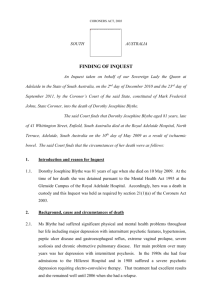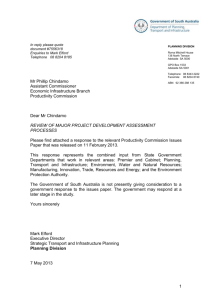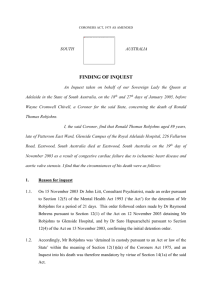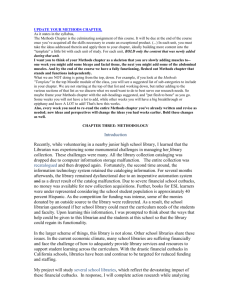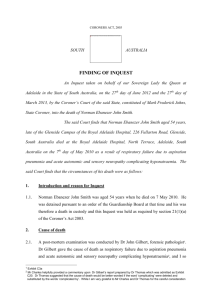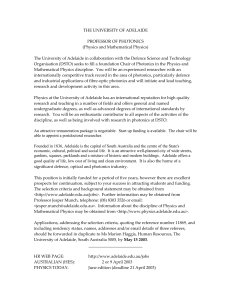CORONERS ACT, 1975 AS AMENDED
advertisement
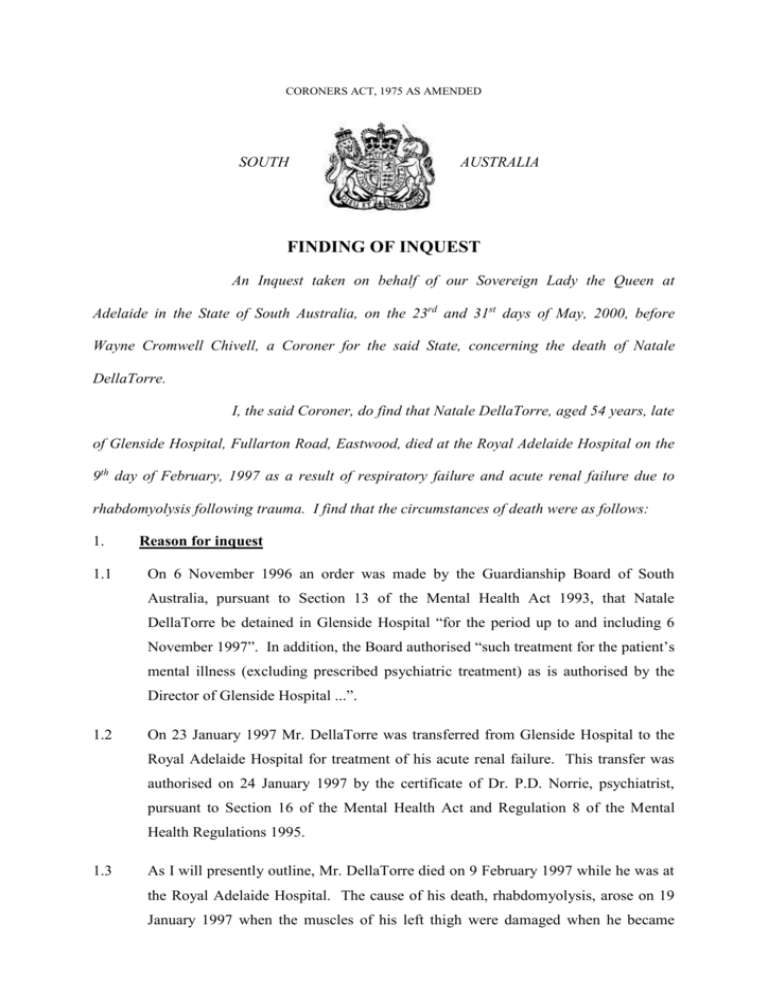
CORONERS ACT, 1975 AS AMENDED SOUTH AUSTRALIA FINDING OF INQUEST An Inquest taken on behalf of our Sovereign Lady the Queen at Adelaide in the State of South Australia, on the 23rd and 31st days of May, 2000, before Wayne Cromwell Chivell, a Coroner for the said State, concerning the death of Natale DellaTorre. I, the said Coroner, do find that Natale DellaTorre, aged 54 years, late of Glenside Hospital, Fullarton Road, Eastwood, died at the Royal Adelaide Hospital on the 9th day of February, 1997 as a result of respiratory failure and acute renal failure due to rhabdomyolysis following trauma. I find that the circumstances of death were as follows: 1. 1.1 Reason for inquest On 6 November 1996 an order was made by the Guardianship Board of South Australia, pursuant to Section 13 of the Mental Health Act 1993, that Natale DellaTorre be detained in Glenside Hospital “for the period up to and including 6 November 1997”. In addition, the Board authorised “such treatment for the patient’s mental illness (excluding prescribed psychiatric treatment) as is authorised by the Director of Glenside Hospital ...”. 1.2 On 23 January 1997 Mr. DellaTorre was transferred from Glenside Hospital to the Royal Adelaide Hospital for treatment of his acute renal failure. This transfer was authorised on 24 January 1997 by the certificate of Dr. P.D. Norrie, psychiatrist, pursuant to Section 16 of the Mental Health Act and Regulation 8 of the Mental Health Regulations 1995. 1.3 As I will presently outline, Mr. DellaTorre died on 9 February 1997 while he was at the Royal Adelaide Hospital. The cause of his death, rhabdomyolysis, arose on 19 January 1997 when the muscles of his left thigh were damaged when he became 2 trapped while trying to scale a fence at Glenside Hospital. On both dates he was “detained in custody pursuant to an Act or law of the State” within the meaning of Section 12(1)(da) of the Coroners Act, and an inquest was therefore mandatory pursuant to Section 14(1a) of the said Act. 2. Introduction 2.1 Mr. Natale DellaTorre had a long history of mental illness, having been first diagnosed with schizophrenia when in his teens. He had also been diagnosed with an intellectual disability at a very early age. He had a total of 28 admissions to psychiatric institutions, initially at Hillcrest Hospital, and later at Glenside Hospital. His last admission to Glenside Hospital had occurred in 1992, and he had been an inpatient there until the time of his death. 2.2 At about 3.15p.m. on 19 January 1997, a patient alerted a staff member at Glenside Hospital that Mr. DellaTorre was hanging upside down on the perimeter fence around Karingai Ward. It took some time to extricate Mr. DellaTorre from his predicament. Because it was suspected that he may have sustained a fractured femur, he was taken to the Royal Adelaide Hospital for assessment, but was discharged that same afternoon when the X-rays were negative. 2.3 Over the next few days he was treated conservatively, but on 23 January 1997 he developed renal failure and was transferred back to the Royal Adelaide Hospital. 2.4 At the Royal Adelaide Hospital rhabdomyolysis (an acute disease causing destruction of muscle tissue, which can lead to multiple organ failure and death) was diagnosed. Mr. DellaTorre’s condition fluctuated considerably, although he remained very seriously ill. 2.5 On 9 February 1997 Mr. DellaTorre’s condition deteriorated and he died at 4.30p.m. that day. 3 3. Cause of death 3.1 A post mortem examination was conducted at the Institute of Medical and Veterinary Science on 11 February 1997 by Dr. A.M. Mahar under the supervision of Dr. D.J. Meredith. Dr. Mahar’s findings are summarised in the “Correlation” section of her report:“At post mortem examination the injuries previously documented by medical staff and attributed to Mr. DellaTorre’s attempt to abscond from Glenside Hospital were identified. The most severe of these was the injury to the left thigh which was swollen and bruised and had a curved marking with central blistering. Examination of muscle groups within the anterior compartment of the thigh revealed extensive necrosis. No muscular tears were identified. The overlying fat contained necrosis and cystic spaces. Histological examination confirmed the presence of acute necrosis with granulation tissue and a fibrous scar. The kidneys were enlarged, congested and on histological examination numerous pigmented casts and red blood cells were evident within the tubules. Both lungs were increased in weight and contained extensive organising pneumonia and oedema. Foci of acute bronchitis were also evident. The findings are entirely consistent with the history of rhabdomyolysis secondary to extensive muscle injury with resultant myoglobinuria and the development of acute renal failure. Rhabdomyolysis may occur as a result of crush injury to muscle and ischaemic damage among other causes. Both of these causes may have been responsible in this instance. The injury occurred on a day on which the temperature was 36.8 degrees Celsius. The length of time for which Mr. DellaTorre was caught on the fence is unknown. Thus, dehydration resulting from the high temperature was probably a contributing factor. The cause of death was a combination of respiratory failure due to widespread organising pneumonia along with acute renal failure secondary to myoglobinuria and rhabdomyolysis. The rhabdomyolysis was a result of injuries sustained to the left thigh resulting in a compartment syndrome”. (Exhibit C.2a, p6-7). 3.2 Dr. Mahar’s diagnosis of the cause of death was respiratory failure and acute renal failure due to rhabdomyolysis following trauma (p.1). I accept Dr. Mahar’s diagnosis and find that this was the cause of Mr. DellaTorre’s death. 4. Issues arising at inquest 4.1 Psychiatric treatment administered at Glenside Hospital As I have already outlined, Mr. DellaTorre had been a patient at psychiatric institutions in South Australia since he was a young man. He had been in Glenside Hospital since 1992, and had been in Karingai Ward since 1996. He had a long 4 history of aggressive and difficult behaviour, and was a habitual absconder (see the statement of Registered Nurse Hay, Exhibit C.6a, p2). Staff at Glenside Hospital attempted to deal with his behaviour by requiring him to report on an hourly basis, and if he complied he received rewards such as cigarettes. 4.2 From a consideration of the Glenside Hospital casenotes (Exhibit C.21), and of the report of Dr. Tony Davis, a consultant psychiatrist who provided me with an overview of Mr. DellaTorre’s treatment, Mr. DellaTorre’s illness was clearly resistant to treatment. Despite the best efforts of medical and nursing staff at Glenside Hospital, he continued to abscond. As Dr. Davis observed:“Upon reading the attached material and reflecting on the difficulties encountered in his management over many years, I consider that the psychiatric treatment was appropriate, and it certainly appears that staff went to great lengths to try and contain his impulsive and sometimes aggressive behaviour. The issue of absconding was clearly a major concern, and this was managed as well as could be expected, short of placing Mr. DellaTorre in a closed ward such as Kurrajong or Brentwood for an indefinite period. I consider that this option would have been unduly restrictive and controlling, and not appropriate to the management of a person with a chronic psychotic illness, and the need for chronic care in an inpatient setting”. (Exhibit C.18a, p2). 4.3 Having considered this material, I find no grounds for criticism of the treatment Mr. DellaTorre received at Glenside Hospital. 4.4 Initial injury and treatment at the Royal Adelaide Hospital Mr. DellaTorre was last seen by Registered Nurse Hay at 2.45p.m. on 19 January 1997. At 3.15p.m., a patient alerted her to Mr. DellaTorre’s predicament, hanging upside down from the perimeter fence, having apparently attempted to abscond again. 4.5 Having extricated Mr. DellaTorre from the fence, Dr. Tania Fiori made the following note of his condition:“... he clearly had a large bruise of his left thigh, ... looked like a burn, like the soft tissue had been compressed and there was a clear mark where he has been hanging from ... so my concern was to assess the (leg) physically”. (Exhibit C.10a, p3). As Dr. Fiori was concerned that he may have suffered a fractured femur, she referred him to the Royal Adelaide Hospital for X-rays. 5 4.6 At the Royal Adelaide Hospital, Mr. DellaTorre was seen by Dr. J.W. Harding in the Accident and Emergency Department. Dr. Harding’s present whereabouts are unknown. He gave an interview to Senior Constable Muir on 5 February 1998 as part of the investigation. His statement has been received in evidence, but has not been verified on oath. 4.7 Dr. Harding examined Mr. DellaTorre and noted an “arch-shaped depression within a white area” on his left thigh (Exhibit C.13a, p2). He arranged for blood tests to be undertaken, but he did not comment on the results in the casenotes. He told Senior Constable Muir:‘that would indicate to me that I didn’t think they were significant’ (Exhibit C.13a, p5) 4.8 Dr. Harding also arranged for an X-ray of Mr. DellaTorre’s leg, and this showed no fracture. He made a diagnosis of bruising and/or burns to the leg and discharged Mr. DellaTorre back to Glenside Hospital for ongoing care. 4.9 Dr. C.J. Baggoley, the Director of Emergency Services at Ashford Hospital, and the Consultant Medical Director for the Adelaide Community Healthcare Alliance, is a person with high qualifications and very wide experience in the field of emergency medicine. Dr. Baggoley has provided a report concerning treatment administered to Mr. DellaTorre. 4.10 Dr. Baggoley disagrees with Dr. Harding’s assessment of the blood test results, echoing the comments of Dr. Faull, the Consultant Nephrologist to the renal unit at the Royal Adelaide Hospital, that these results should have raised “alarm bells” (Exhibit C.16a, p12). Both doctors suggest that the elevated potassium level, in particular, was consistent with an incipient rhabdomyolysis (see Exhibit C.19a, p2). 4.11 However, Dr. Baggoley does not criticise Dr. Harding’s failure to diagnose rhabdomyolysis at this stage. He said:“I do not believe that Dr. Harding’s failure to follow up on indirect evidence that may have led to further tests which came to a diagnosis of rhabdomyolysis is a serious error. Using the term ‘error’ in these circumstances could even be regarded as harsh. Rhabdomyolysis is not a common condition and I have not encountered it in the situation of isolated injury to the thigh”. (Exhibit C.19a, p2). 6 4.12 I accept Dr. Baggoley’s evidence on this issue, and offer no criticism of Dr. Harding’s treatment in all the circumstances. 4.13 Treatment of Mr. DellaTorre upon return to Glenside Hospital Upon his return to Glenside Hospital, Mr. DellaTorre was monitored carefully. His psychotic condition sometimes made it difficult to obtain appropriate urine samples for testing. On 23 January 1997, Dr. Georgette Michail became concerned at Mr. DellaTorre’s low urine output, and transferred him back to the Royal Adelaide Hospital, with a diagnosis of acute renal failure. 4.14 Dr. Baggoley was most complimentary of the care Mr. DellaTorre received during this period. He said:“I have no criticism at all of the management of Mr. DellaTorre at Glenside Hospital during this time, even though during this time period the opportunity to prevent renal failure complications of rhabdomyolysis passed. As Dr. Faull indicated (page 9, line 29) acute renal failure cannot always be prevented, even if rhabdomyolysis is diagnosed early. Examining the notes and transcripts relating to Mr. DellaTorre’s Glenside Hospital phase, I was most impressed. Nursing care recorded attention to fluid input and output. The suspected reduction in urine output was followed up by the nursing staff and by Dr. Michail in a most timely fashion. Staff at Glenside could have been forgiven if they had not been so assiduous, given that Mr. DellaTorre had been assessed at the Royal Adelaide Hospital and the R.A.H. response was low-key. Dr. Michail’s actions in taking a blood test soon after there was concern expressed about urine output, and the response on receiving the results, were exemplary”. (Exhibit C.19a, p2-3). 4.15 I accept Dr. Baggoley’s views on this issue, and see no grounds for criticism of the medical or nursing staff at Glenside Hospital for the treatment Mr. DellaTorre received during this period. 4.16 Treatment at the Royal Adelaide Hospital Mr. DellaTorre arrived back at the Royal Adelaide Hospital at around 2.00p.m. on 23 January 1997. He was seen by Dr. C.M. Price in the Accident and Emergency Department, who, after some preliminary investigations, formed a diagnosis of rhabdomyolysis and renal failure (see Exhibit C.14a, p3). 4.17 Mr. DellaTorre was initially admitted to the Renal Unit, and on 24 January 1997 he was seen by Dr. Chong Ghee Chew, a Nephrology Registrar, who formed a 7 diagnosis of “acute tubular necrosis” leading to advanced renal failure (see Exhibit C.15a, p2). 4.18 On 28 January 1997 it was decided that Mr. DellaTorre should receive dialysis treatment, in the course of which a “Vascath” needle was inserted into a central vein leading to the heart. As dialysis continued, Dr. Chong noted that Mr. DellaTorre became hypoxic, and his blood pressure dropped alarmingly. improved when dialysis was completed. His condition He was then transferred to the High Dependency Unit. 4.19 It was later discovered that Dr. Chong had, in fact, inserted the cannula into the subclavian artery, rather than into a vein, and that this was probably the explanation for the hypoxia and drop in blood pressure. Having regard to his recovery following the procedure, and his ongoing state, it seems unlikely that this contributed to the eventual outcome. 4.20 When Mr. DellaTorre was admitted to the High Dependency Unit, he was intubated and ventilated, during the course of which he suffered a cardiac arrest and ongoing arrhythmias, which required defibrillation. He also suffered ongoing acute psychosis, which created additional difficulties for those attending him. For example, at one stage he manually extubated himself. 4.21 On 6 February 1997, Mr. DellaTorre underwent a surgical tracheostomy, as a result of which his condition improved somewhat, but unfortunately, on 9 February 1997, he suddenly developed further acute renal failure, his blood pressure and oxygenation dropped considerably, and his respiration rate increased. Further dialysis was attempted, but this was unsuccessful as Mr. DellaTorre’s blood pressure was insufficient. Adrenalin was administered without good effect. 4.22 During this period, Mr. DellaTorre had developed organising pneumonia, which can appear with rapid onset, and his condition rapidly deteriorated. His life was declared extinct at 4.30p.m. on the afternoon of 9 February 1997. 5. Concerns expressed by the DellaTorre family 5.1 I have received a letter (Exhibit C.22) signed by Messrs John and Dante DellaTorre and Mrs. Lorraine DellaTorre, the brothers and sister-in-law of the deceased. The family believe that a decision was made to “withdraw treatment” from Mr. 8 DellaTorre without adequately consulting them. They asserted that Dr. Hagley, the Intensive Care Consultant, had suggested to them that such a decision was a medical one, and that they had no say in it. 5.2 It seems to me that a rather unfortunate breakdown of communication has occurred between the family and Mr. DellaTorre’s treating doctors. In the Royal Adelaide Hospital casenotes (Exhibit C.20), Dr. Hagley has filled out a form entitled “Revision of Treatment”, in which it is indicated:“It is therefore intended: 1. Continue existing, but initiate no new treatment ... 4. Cease inotropes”. This form is undated, and it would appear that Dr. Hagley has signed it, both on his own behalf as “Intensive Care Consultant in Charge”, and on behalf of Dr. Gilligan (“other Intensive Care Specialist”) and Dr. Clarkson (“for parent clinic consultant”). Having read Dr. Hagley’s statement (Exhibit C.17a, p8), I am satisfied that all three doctors concurred in the prognosis. However, I would suggest to Dr. Hagley that it is an unwise practice to sign the form on behalf of other doctors, and that, if the form is to have any credibility, it should be signed personally by the doctors concerned. The form should also be dated. 9 5.3 In answer to the family’s criticism, Dr. Hagley said:“Our position generally is to tell the family that we certainly listen to their opinions and they are important to the overall question of management, but that if the general consensus amongst the medical staff is that further support is futile, then we generally ... express that opinion to the family and await their reaction to that opinion. ... All I can say is that if we withdrew therapy and the family were absolutely adamant, or even one member of the family was absolutely adamant they didn’t want it to occur ... we wouldn’t have done it at that specific time”. (Exhibit C.17a, p4-5). 5.4 It seems that the DellaTorre family understood Dr. Hagley’s advice as presenting them with a fait accompli. Dr. Hagley, on the other hand, seems to have interpreted their lack of reaction to his advice as acceptance of it. It is never easy, in retrospect, to form a clear conclusion as to how such misunderstandings have arisen. It is vitally important that close family members understand the issues being discussed and their rights to be involved. 5.5 To add to the family’s confusion, it would seem that no notice was taken of the form anyway, since further attempts to dialyse were made, and inotropes (adrenalin) were given when Mr. DellaTorre’s condition deteriorated further. 5.6 This is not an issue which is directly concerned with the cause of Mr. DellaTorre’s death. His family do not suggest that the outcome would have been any different had this misunderstanding not occurred. Accordingly, I am not empowered to make a recommendation pursuant to Section 25(2) of the Coroners Act, since that power is confined to situations where I consider that a recommendation may prevent similar deaths in future. However, I draw the issue to the attention of the Director of Intensive Care at the Royal Adelaide Hospital, on the basis that a misunderstanding has apparently occurred in this case, and that he should consider what steps can be taken to avoid such misunderstandings in future. 5.7 In all the circumstances, and having regard to the opinion of Dr. Baggoley, Dr. Faull, Dr. Hagley and the evidence in general, once Mr. DellaTorre’s rhabdomyolysis had become fully established, his eventual demise became almost inevitable. He was treated comprehensively and aggressively at the Royal Adelaide Hospital, and there is no evidence before me which gives any ground for criticism of that treatment. Even after Dr. Hagley drew up the “Revision of Treatment” form, further attempts to treat him were made, but to no avail. In those circumstances, it seems to me that everything was done that could have been done for Mr. DellaTorre. Key Words: death in custody; rhabdomyolysis; hospital treatment In witness whereof the said Coroner has hereunto set and subscribed his hand and Seal the 31st day of May, 2000. ……………………………..……… Coroner Inq.No.25/2000
